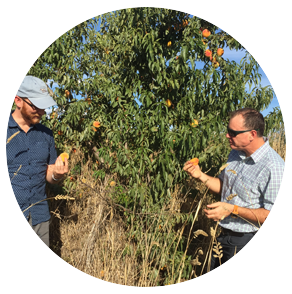Step 2 – Define and investigate your area: where could flies be?
Defining an area to manage is an important foundation for being able to put an effective plan in place. So, think about your area with an AWM mindset.
Things to consider about your area
It is likely that you will have commercial and urban areas to contend with. This means a variety of host crops, a prolonged period of host susceptibility, and multiple groups of people to involve. If you map out these factors, you won’t miss anything as you progress with implementing and conducting AWM.
 Experts tell us that Qfly uses a variety of fruits as hosts and will search across a landscape within a radius between 500 metres and 2 kilometres. Any suitable fruit within these distances can be a potential source of Qfly.
Experts tell us that Qfly uses a variety of fruits as hosts and will search across a landscape within a radius between 500 metres and 2 kilometres. Any suitable fruit within these distances can be a potential source of Qfly.
In areas where there are multiple hosts available all year round, Qfly can build up high population densities – so look around. Pay special attention to features of the surrounding landscape – especially other host trees which might be sources for Qfly. You might even be able to identify unwanted fruit trees or other host plants that are best removed.
 Be aware of when each commercial crop is susceptible, and how this relates to other crops. Mid and late season crops may be at risk from early crops because they could harbour fly populations that move on later in the year. Similarly, early-season crops will be more at risk from overwintering flies or flies emerging from pupae. Consider spots where the flies might have been overwintering (such as late-season crops with fruit left on trees, abandoned orchards, or even dense windbreaks around fields).
Be aware of when each commercial crop is susceptible, and how this relates to other crops. Mid and late season crops may be at risk from early crops because they could harbour fly populations that move on later in the year. Similarly, early-season crops will be more at risk from overwintering flies or flies emerging from pupae. Consider spots where the flies might have been overwintering (such as late-season crops with fruit left on trees, abandoned orchards, or even dense windbreaks around fields).
Mapping risk factors such as these this will help inform your next step – monitoring the flies to get a better idea of where and when they are in the landscape. You can also find more examples in the science section.

